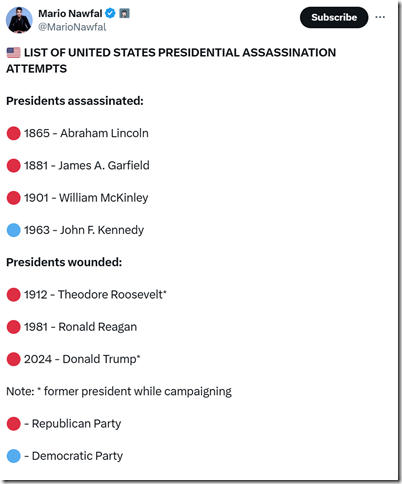Quote of the Day
The post-debate Biden situation has so far been all about electoral viability, with the news media’s entire focus is whether Democrats can win in November by dumping him for someone else. Horse race and such.
Which is stunning, because the main story should be that this is one of the biggest political scandals in history, and a legitimately massive conspiracy to keep Americans in the dark in order for Democrats to cling onto political power.
Seriously, think about the complete picture here. The President of the United States, the most powerful person on the planet, is suffering a rapid cognitive decline. Dozens of members of his party as well as “journalists” and celebrities have known this for many months, as they finally admit (because it is now advantageous to do so).
But what were they doing right up to the debate? Completely denying it. The New York Times and others even ran bullshit “fact checks” of videos of Biden struggling, telling us not to believe our own lying eyes. Save for maybe Dean Phillips and Robert Kennedy Jr., no Democrat politician would dare suggest Biden was in decline. They all tried to cover it up.
I think this may be the biggest conspiracy in American political history. It’s at least the biggest since Watergate, but even Watergate didn’t implicate this many co-conspirators. The Biden covverup involves pretty much all Democrats who regularly interact with Biden trying to hide his condition, from members of the House all the way up to the Vice President and the cabinet. They put their own political fortunes ahead of the good of the country – at least until it was time to stab Caesar for their own political benefit, once the debate made maintaining their lie untenable.
And maybe you expect that sort of craven political behavior from politicians. But the news media? We are now getting reporters proudly publishing pieces about scary interactions with Biden that happened 6 months ago or more. Where were these reports when those interactions happened? Only rightwing media covered Biden’s decline honestly (no doubt because it served them of course), but rightwing media doesn’t have the same access to him. The rest of the news media appears to have colluded with Democrats to hide Biden’s condition in order to help them stay in power.
And now, all these people now have the gall to talk to us about “Saving democracy”? Seriously? Eat shit.
The Democrats should be held accountable for this by suffering major losses in November. The news media should continue to lose trust, as it has proven more than ever that most of it is just a PR firm for Democrats.
Crazy that they are going to get away with what should be a cataclysmic scandal.
Kostas Moros @MorosKostas
Posted on X, July 10, 2024
“Appears to have colluded..”? It’s well beyond “appears”.
It was obvious to me, and I’m sure millions of others, that Biden was suffering from dementia four years ago. I specially remember telling someone I could not vote for someone with dementia (and getting an extremely emotional denial). Some people were in denial. Some were oblivious. But the majority of people with access to him had to have known for years.
They knew and made a decision to say nothing about the most powerful person on the planet being feeble minded.
Like this:
Like Loading...



